| Menu | JAQForum Ver 19.10.27 |
| Menu | JAQForum Ver 19.10.27 |
Forum Index : Other Stuff : Battery Experience
I think we have all had experience with phone batteries, with there higher charge voltage, and are lithium polymer last I looked, not really meant to last long in that application, notebook battery packs also not really meant to last long in that application, they don't really compare with LiFepO4 off grid storage.....Different in many ways. Years ago my farther had a friend that we met through similar interest, restoring old engines and things, the friend also worked for Telecom as some sort of system consultant, in doing so the old FLA 48v battery setup needed to be removed before the new updated system could be installed, all we had to do was pick up the batteries and sometimes a battery charger as well. It worked in nicely and was a good deal as most of it was local, it was surprising to me where some of these batteries where located, there was one large system in a school, not the sort of thing they do these days. Over some time we had half a dozen 20Amp and 50Amp battery chargers and a few 48v battery strings, some batteries were not in good shape, but it was just a case of selecting the best out of a batch. Thought we had enough batteries to play with and Didn't bother going to pick up any more as there were other jobs to be done, later on a few occasions some other people dropped in a few more sets of unwanted batteries, one lot was all AGM 2v 200AH I think Challenge brand, made in the UK, tried them but not a single one of them was any good, they were already swelled on the sides of the cases. Another day I come home from school there was another load of old batteries dropped off on the side of the driveway, apparently someone else also had a job of getting rid of old FLA batteries and Didn't want these, they where old 2v Dunlops, most of them were past salvageable. There were a few that we tried to charge and not much was happening, so we reversed charged them, took some time but the amp meter was starting to show signs of life and the battery developed some heat, they where then discharged and charged to the right polarity. I don't remember how well they lasted compared to the others. After a lot of sorting through all these batteries and some years past, we scraped a lot of those that were no good, and where left with a few Thousand Amp Hours and several 48v sets with battery charges wired up and all. They would get a charge every 2 months to help keep em happy and only ever topped up the water once that I can remember, Didn't have much use at the time, just run some electrical equipment, 8 of the best 6V 90Ah batteries where selected to be used for electric traction motors for the Train club running days about twice a month, they did well for a few years. After a few more years, more of the batteries had deteriorated, there was about 10 years age difference between some of these batteries, cells dropped, terminals corroded and fallen off, terminals blown off and the plastic cases were cracking and leaking acid, sometimes bad cells (on 6V batteries) were jumped over.  Some where usable at 15 years old, many where failing, all where stuffed at 20 years, that was 20 or more years ago, was very little interest in off grid usage back then never thought much of it.  These are in the scrap pile, A lot of these had vent caps, some were plastic beads sort of moulded together, the others had some heavy stuff that looked a lot like those pink grit grinding stones, probably some help in keeping the water level up. This is one of the 2v 200AH batteries with the case removed, being deep cycle rated, the plates are very thick and long lasting compared to the rest of the starting type batteries, that's the way it used to be.  My first experiment with off grid, consisted of 2 N70T deep cycle batteries, auto XS 12V modified square wave inverter 20Amp PWM REG and 150W solar panel, All off the shelf stuff that was available At the time. Initially the results where good, it run the fish tank pump and aerator, all up with inverter consumption was about 14W continuous 24/7, with the occasional Equalise charge. After about a year 1 battery took a dump, the second one was still going and would still last over night, it went for another 6 months before it had low voltage cut out by 5:00AM, kept it running and it was just cutting out earlier overtime until it cutout at sunset, Didn't have so many fish that it needed power all the time. the N70T batteries had no warranty back then and priced accordingly, there where at the time some 106Ah deep cycle batteries available for twice the price, I suspect they were deep cycle as the N70T at the time were just starting batteries (with a deep cycle label) with thin plates, still perfectly usable for those doing a camping trip, as the reviews show. Since then we just put in an old used car battery and use them till they die, been doing it ever since. I remember when I was younger, my father and I went to Century Batteries Cobalt St, Carole Park QLD 4300, at the gate there was place where you could by batteries, he got a blemished battery think it was about 600cca at the time and he was grumbling about the price at $40, got few that way, payed a little more later, one of them had 2 positive size terminals....... Look what we pay these days. I had a distant relative that works in the battery industry, My Uncle phoned and said this fella has some batteries that are going to be dumped, variety of notebook batteries, some were from UPS units cordless drill batteries and some other lithium based battery packs etc. After looking at the crate loads of Sh*t I put it all in the shed and left them for a week until I gathered enough interest to take a look at it all. Started ripping the notebook batteries apart, some were quite difficult to open, used hammer and chisel to start a few off, removed the circuit board from the few I had opened up and checked each 18650 cell with a multimeter found a few of them still had a reasonable voltage, some were pretty much flat. Was interested to try these as I had never had any lithium 18650 cells before, wired some up a 3s 2p for a 12v Hitachi cordless drill that previously had NiCad's in, put the cells inside the battery pack and wired the terminal up and tested it out, seemed ok, Charged them up, used it for a bit and give it to the old man to use, was quite happy with it. Ended up running it till it went flat, it would suddenly die while in use, try in again a bit later and it would run again drill another hole and just suddenly die again, the NiCad's would slow down gradually in comparison. Unknown to me at the time, I would have been driving a pair of the 18650 cells in reverse leading them to there death, strange that the cordless drill would just stop, (looking back now, it Didn't keep running and kill the 2 cells immediately), managed to get a fair bit of use from that battery. I have run another motor with these and it kept running driving the cells in reverse and that killed them first time. Continued removing cells from packs, found a few that had a substantial dent in the side of the cells, looking at the case found no damage or marks of any kind, so the damage to the cell's was there during installation (WTF was quality control doing when that went in?) somehow it still worked. Took some time but got a substantial amount of cells to start experimenting with, tested and charged them all to 3.15V as that should be a safe margin, from the little research I had done. I had A gut full of taking apart plastic battery packs, so a few days after each batch was charged I checked the voltage of each cell to see if there was any voltage drop, there were some, and they were put aside to deal with later.....this process took weeks. The ones that where holding charge, were arranged in groups of 10 and wired up and solder on to all the ends of the cells, some of the notebook batteries 3s 2p and 3s 3p charged and tested ok so wired them up as big slabs. I think at the time to get 48v at about 180AH (using the 2AH average to go by) , 13S 90P and was tired of wiring all this stuff up, we were running the house off grid during the day with a set of 4wd batteries and a 4048HS inverter. Old Man said "why not connect it to the inverter and run the house with it" I had no idea how it would go with balance over night or if it would burn up and be a disaster, But F*%#k it, worth a try.......Quite a surprise that it was ok in the morning.....2016.   It took a bit of time to learn its behaviour and tune the charger settings, bulk charge and float voltage was adjusted to be quite close, some cell balancing was required, just used a car head light to bring down the cells that were a little higher than the rest. I did look into a BMS at the time but was not satisfied with what was available, so just checked the cell voltage each day almost at the end of the bulk charge stage, eventually found it to be good enough to do manual cell balancing almost every 2 weeks, these cells did not run away with high voltage when getting close to fully charged (could be just the way I configured it), leaving me plenty of time to any balancing, in comparison LiFePO4 cells do run away very quickly when close to fully charged (depending on users definition of fully charged voltage) it was going well and they were taking all the charge that was available from the solar panels installed at the time. Over time I striped down some more battery packs did all the checks, charged them and made up another 48v battery bank, this was about half, more was added but seem to have lost the photo, eventually increased the first lot to 100p and the other is 13S 90P in an old tool box..........2017 Plus A bit.  The youngest cell is built 2012 the others go back to about 2009 When charging these 18650 Lithium's 13s 100p and the other pack 13s 90p to 53.3v is 4.1V per cell, Then it will go to float 53.2 some might be 4V some as high as 4.13 my upper limit is 4.15, if any get to 4.15 then its time to take action and deal with it, (always had plenty of time to catch it) connect a car headlight to that cell until bulk charge has finished, I have also left the headlight connected to a cell group for the rest of the day (got distracted by some other job that needed doing) come back and the cell reads 4V, hasn't been a problem so far, for the few times this has happened. The biggest annoyance with this is that it was 2 separate battery banks but still parallel at the end terminals, giving me 26 cell voltage checks to do. They have done very well over the years Despite having the battery leads 3 meters long, over all the years that these have been running, about 8 or so cells have be discarded over the duration because they had a small internal short and developed a little bit of heat above ambient, just replaced them with a few others that where laying about. As for all the WWW, Alarmists that said they are highly dangerous and would cause a fire..............not a single cell has ever smoked or burnt, having said that, most of the cells were good well known brands and have internal fuse, internal fuses will not stop the slow internal short that a few cells had. I had a few of those high power (AGM battery) jump starter packs over the years...very handy, used them many times to help start diesel engines, The last one was a 1900CCA was quite a heavy lump to Carry around, it outlasted the earlier ones by a fair margin. The last time I used it to start the lawn mower a few times and it did well, it was about time to give it a charge, using its own inbuilt charger and plug pack as usual, left it over night and checked it the next day, it was showing full charge. A day later I could hear a buzzer going off on occasions, found it to be the jump starter that I thought I had fully charged, without checking it I plugged the charger back in and left it for the rest of the day. Checked the battery voltage at the output plug and it was over 15V and the plug pack was hot, left it sit for a while and the buzzer was going again, tried to start the mower with it......nope just a solenoid click....batteries are stuffed. I think the internal battery charger Sh*t itself and ended the batteries life. Removed the pair of AGM batteries from the jump starter, they where sitting in a nice plastic box, I still had a few lithium battery packs (some sort of medical exchange type) all of them were 3S 3P arrangement, took the circuit boards out and wired them up as parallel packs, 16 of them. The overall voltage was a bit low compared to the standard FLA Battery but still did a good job to help start many things.....No BMS, did well for a few years. The last Time It was used I Stuffed it up.....Some stupid moment of not thinking, connected it to the starter motor leads that were not COLOUR coded wiring and had an internal solenoid and no system ground, it already had a starting battery connected, turned the switch on the jumper pack and was about to start the engine, then saw an Immense amount of smoke coming from the booster pack, knowing that it could be the highly flammable lithium cells that had finally caught fire, I tore off the clamps and cables and threw the jump starter out the way and left it till the smoke died down.....Didn't take as long as expected. Decided to open the battery jump starter to see the destruction, to my complete surprise it was the wires that had burned not the cells, checked the battery output and no power. Checked a few cells and they were ok, as it turns out all the packs had a 10Amp thermal fuse, all 16 of them were blown and the connections had been really hot and burnt. .jpg) .jpg) After checking all the cells were ok, they were taken apart and rewired into groups and added to those that were already running the house, no problems. As of mid February 2021 I have moved on all these lithium 18650 batteries to the shed (in a fire proof Box) and they will be reconfigured into better matched groups and shorter higher current leads........I might get another year out of them in the shed.....they likely wont be used much over night. I think the lower charge end voltage (4.15) and very small usage 30% of its capacity, minimal current draw per cell helped them last a bit longer. Also think that the many mini cycles it had per day had bugger all effect on there life span. So I had a Good run with them and BEST OF ALL THEY WERE FREE.......Would I do this again?......YES, but they would have to be free or awfully cheap, and the assembly would have to be much better, perhaps a welder for welding tabs to the cells...soldering wires was a PITA, but made it easy to remove a suspect cell from the pack, could also work on the cells while they were in use. As for cells burning, it is more often caused by an outside influence, impact damage, over charge or discharge and quite often the charge circuit itself, I have a (Practically NEW) cordless drill battery at the moment that is discharging in just a few days, the SOC meter is all over the place, will have to remove a wire or 2 to find the fault, all the cells are good. The house now runs on 16S LiFePO4 (February 2021) and are a year old now and working well. All cells and BMS are mounted in a fire resistant cabinet all secure, have not even bothered to look at or touch them since they were put in the cabinet. There is the well know warnings about over charge over discharge and the rest of it, but with it all setup I haven't found any of them danger points worth worrying about, with charger settings done properly and BMS setting's set to appropriate values so the batteries don't get close to the danger limits. I have no spacial charge controllers for lithium, just use standard charge controller that has custom settings, just change the settings to suit the requirements. Working within the battery voltage limits (safe zone) they are just a battery, no big deal. I do like the stable voltage and sag under load is minimal. .................This bit is just THEORETICAL................ One potentially destructive problem with LiFePO4 is if people run there charge voltage quite a bit lower than the recommended voltage limit 3.3v, 3.4v etc being rather Conservative, just before any of the cells reach full capacity the balance voltage will be mostly or perfectly matched and all appear to be well, but the cell capacity may not be, there is NO way to know how much capacity is in each cell, some of them may not be taking as much charge as others and over time a year or more perhaps that cells capacity will be dropping and no one will know, this will not be a problem at first, but when the user has to do a rather deep cycle as these are expected to do....there is a great risk of the lower capacity cell being driven into reverse, permanently destroying that cell.....IF the BMS Attached did not protect that low voltage cell, normally a BMS would save this from happening but its a bit late to find out if it Didn't. //////////////////////////////////////// I hope I have explained that in a way that could be understood. Still not certain if I have the optimum settings for LiFePO4, seems to be many different views on whats right or not. I suspect I will have to upgrade the BMS at some stage and do a top balance. As with most LiFePO4 cells sold (some other batteries as well), there is no warranty (that I am aware of) once you have paid for them they take no further responsibility for what happens to the cells after, as its up to the end user to set them up according to the specifications, the problem with this, if there is a defective faulty cell from new (factory defect) or cells are fake, there is no way you can convince them that they sold Sh*t, you could test and prove beyond any doubt with video evidence photos and even have them independently tested, an overseas seller can just call you a liar and go get F*****d. Hard to find a trusted seller, the same applies to just about any SMOKE EMITTING DEVICES you can order online. With most things, I will try to use/make use of, what ever I can get my hands on, Its been fun I must say.  I proof read all this but probably still stuffed it up somewhere.  Cheers Aaron Off The Grid |
||||||
Aaron. Thank you for the most informative, description, off your journey through the land of battery's. To the current point. Im shore many will interested in your adventures. Any chance of a February 2021 picture to complete the set. We will all be following with interest. Andrew. |
||||||
as above, thank you... very interesting... good to read some practical experience. I've had a very similar experience with 18650's, ive found one of the most important things is getting the cell capacity matched properly straight away, seem to last better and the bms doesn't need to work so hard .. kudos... |
||||||
Very Good read! It's interesting to hear how people went through different experiences and learning Curves. I was interested in the 18650 Power wall idea a few years back when it was popular but was unable to find a source for the cells so that went no where. I did always wonder though...... The cells are tested and charged and discharged and tested again etc and the capacity's mapped so they can be bundled together. All good and well but as they are usually from failed packs and the failed cells removed, How does one know more cells wont fall over in a month and do many fall over within a year or so of being re purposed and tested? BE happy if I could Find some Decent used lead batteries or had a friend in the game somewhere. |
||||||
Photo or it didn't happen. We put together one set of LiFePO4 cells to run and see how it works, run wires measure things up etc. The battery terminals are laser welded in the shop (never seen that anywhere before) and done the way I want, there are some options. Had to cover all the battery terminals so as not to drop a spanner or link bar across the cells, just wire up one at a time. The cells (on the left 200AH) were configured in 2 rows and room for another set later on the right. Did get another set later when they were on special, connected to a separate inverter/charger and separate house wiring, house was wired that way. My father is getting older and not as tolerable (aircon installed) to hot humid or cold weather, (and putting up with ME) he has earned and deserves to survive a little longer and have the place a bit more livable, overall usage over night is about 4 to 5Kwh.  I always learn more when doing the work myself, manufactures, products, quality control and personal experience quite often varies. |
||||||
With hindsight, getting the proper gear to test the cells would have been the best approach, I might have discarded a lot more cells. With the unknown brand 18650 cells, Found in a few knock off drill battery packs, some cells had failed, others all have failed, didn't like the look of them and never used any of them, Battery brand and quality (with any battery type) vary widely so I don't paint them all with the same brush, so to speak. I never did any capacity mapping, and We don't know how many cells would fall over, and when. The percentage of failed 18650 cells (cause of death unknown in the notebook packs) was only small and was not an indication that the others would fall over next compared to the rest that worked, By now I'm sure there is some cells in there (developed high resistance) that are not doing there job, but as it was running the house easily with power to spare I don't think I'm going to do any capacity checks and it might be a lot of extra work to find those cells that might not be working as good as they should, when it isn't up to the task of running what I want it to, then I will know. Think it will go another year in the shed. I would like to see what these do at the end of there life, will they have a high resistance short, or will they develop high resistance and go open circuit. Initially I was worried about the entire setup getting hot while charging and in use, (as they do in note books and drill batteries and others etc, but that hasn't been the case, Off grid use was easy on them. I was going to suggest the following-----> You might be lucky and find someone working on an NBN installation (have a chat) Think they have battery back up, also I believe the towers also had battery backup, They are most likely going to lithium soon if they haven't already, I looked up Telecom batteries and saw a plethora of it. Now I'm Not so sure if they all still use battery backup, Thursday morning the local area and farms, is without power and the phone towers Didn't work, later on towers are working again, unknown what happened, every one else still had no power, all running generators, those who have one, power back on Friday morning. I don't have any power problem. I might do some updates later if anything change and when I finish rewiring the battery setup in the shed. |
||||||
Time add a bit more user history, My Old Man has been buying and using Century batteries for longer than I can remember, When I was a lot younger we used to buy most of our century batters from the front gate at the factory Cobalt St, Carole Park, we lived not far from there back then so not a big deal to drop in any time. Mostly used to buy Blemished batteries, often nothing wrong with them, just a scratch or marks and a damaged sticker, we could get a good working battery at a reduced price. For those that don't know what blemished looks like Have look, 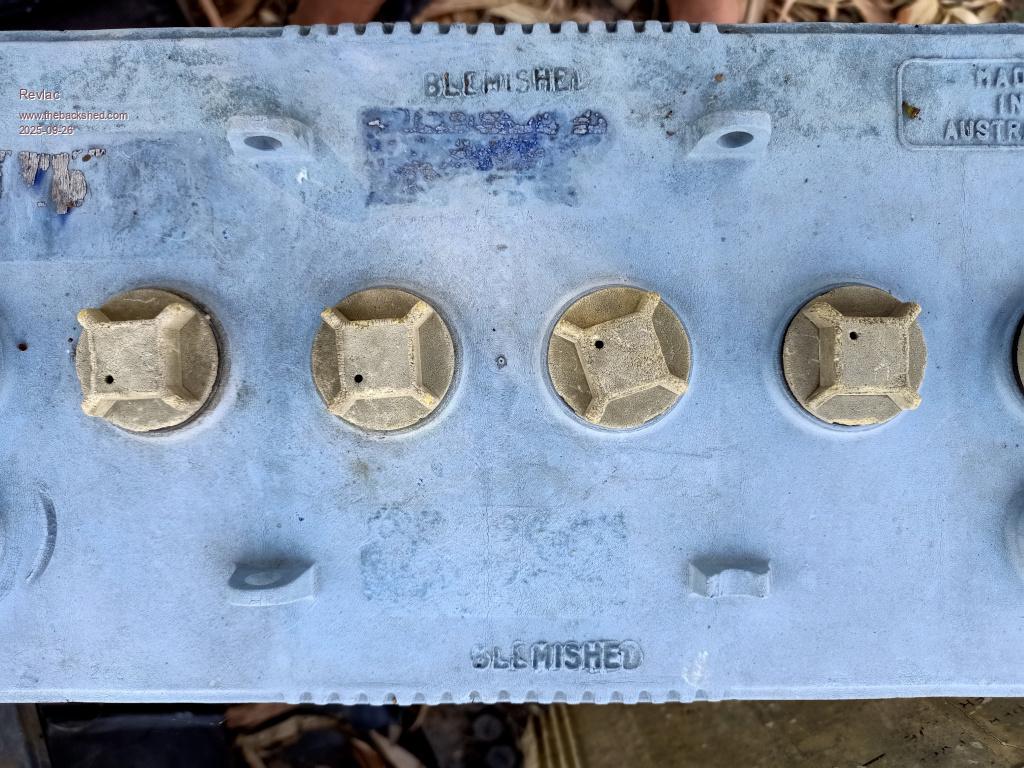 One blemished battery was quite a bit of fun to use, it didn't pass QC because it had 2 large terminal post's instead of the normal POS and NEG post sizes, it was a good starting battery but when its needed in a different vehicle or tractor for starting it was a PITA as post was too big to fit NEG terminal....some swearing followed then opened the brass terminal clamp to fit the post, even more fun watching someone else borrow it. When I was working in that area we had a fellow come in to get some work done, he was a Century employee that I used to do some welding work for, always well dressed chap and good to talk to, he worked for century for some time, good place to work no complaints. The last Blemished Century battery I bought was about $40 but that was a long time ago, we did at one stage have a battery REP come (not sure which company he was from) into the Boat workshop with a new Marine Grade battery to show us the internal baffle design so there was less sloshing when used in small boats. Moved from that area in 2002 and went an hour west, kept buying Century Batteries from local shops but no longer got the blemished batteries and so had to pay full retail, Had all ready started trying different brand batteries, bought our last century battery in 2018, think that went in the car. Getting to the point, these 2 batteries are dated 2016 and 2017 and they are still working now......... 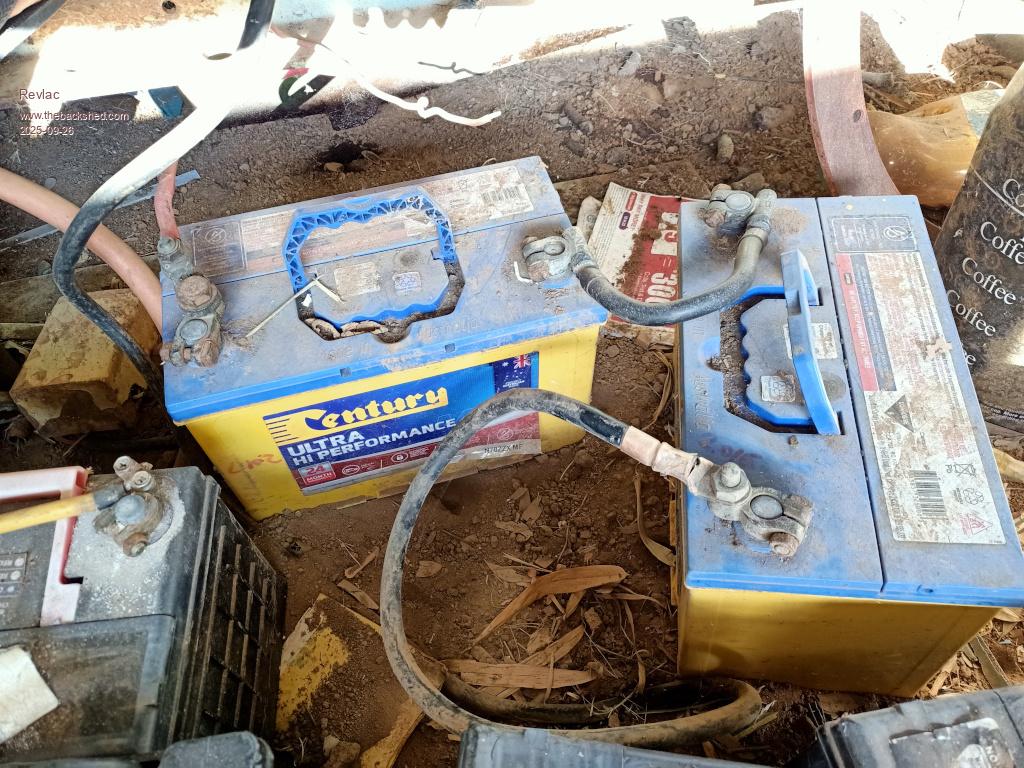 I will explain how and why because some people refuse to come clean with the usage history, these batteries have been used to start the big generator (engine only) and a 671 GM Diesel engine, and only do 3 to 4 starts PER YEAR and maintained with regular charging the rest of the time, they are very tired now and may have a few more starts still in them but not many, This is not good use of expensive batteries compared to those that are used most days several times a day. If they were used for everyday normal use they would not last that many years. |
||||||
I had 6 Cyclons in a pack with welded tab's ----> Enersys Cyclon 2V 2,5Ah Lead Tin Battery D-Cell cant find them to take a picture, I dumped them in the scrap pile because they were gassing off and no longer holding charge, but look them up it might surprise some people that these are still about.  |
||||||
Over the years and several tons of batteries, I have opened probably close to 100 or so Lead batteries most of them deep cycle (melted them down) and were thick plate's as expected, The starting batteries some of them were produced over the last 15 orso years with thinner and thinner plates, other people also noticed this too, While others Deny this is happening and simply don't know, The worst one I have seen a few years back, (I lost the photo's) so taken another few photos now and removed a plate to show. While these did start engines ok the batteries degraded much faster than others used in the same way and in the same equipment. The plate resembles chicken mesh and the entire battery has very little lead in it that could be melted down to make lead weights etc, the only way to to get any lead value is to have it recycled in an industrial process. 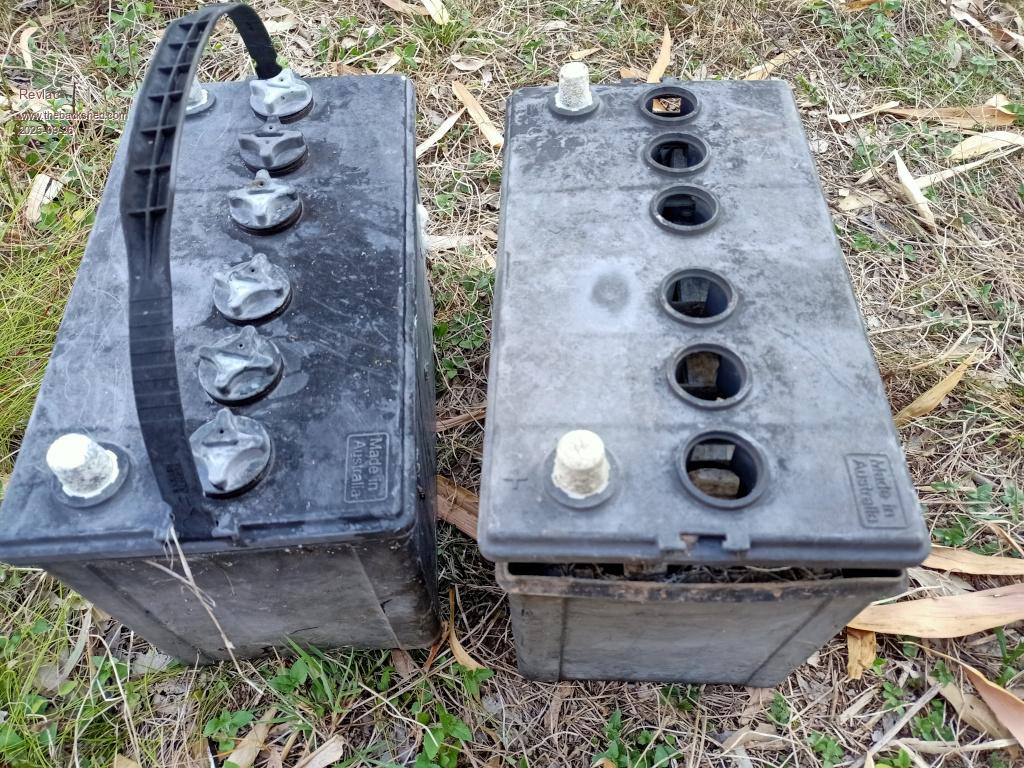 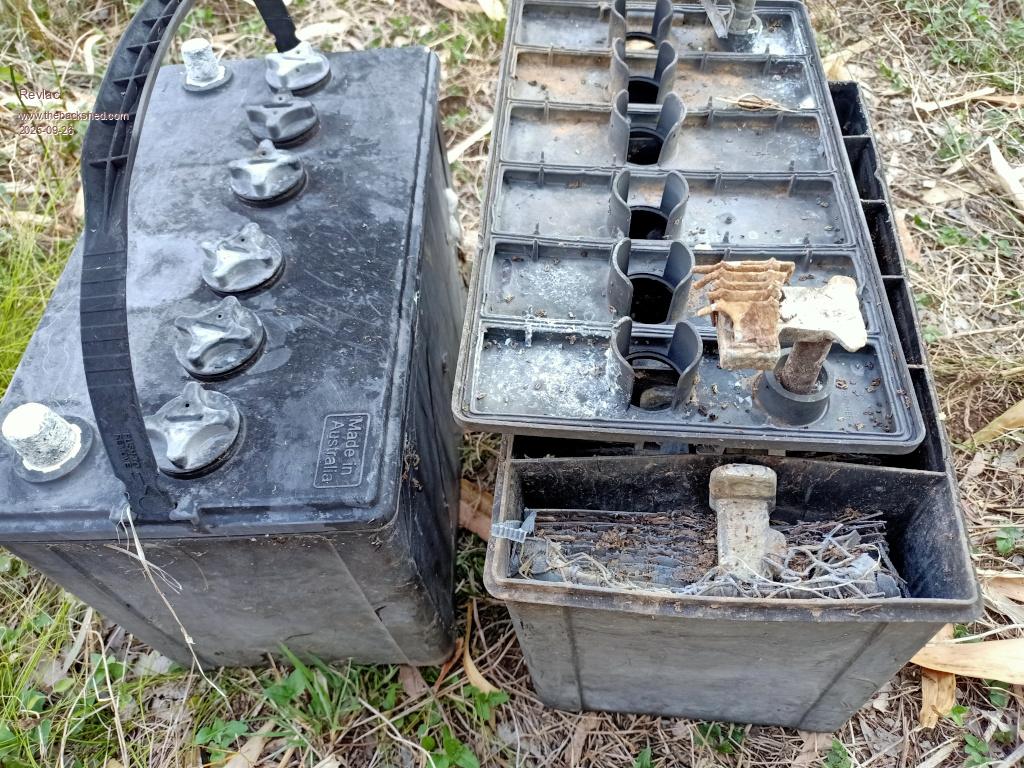 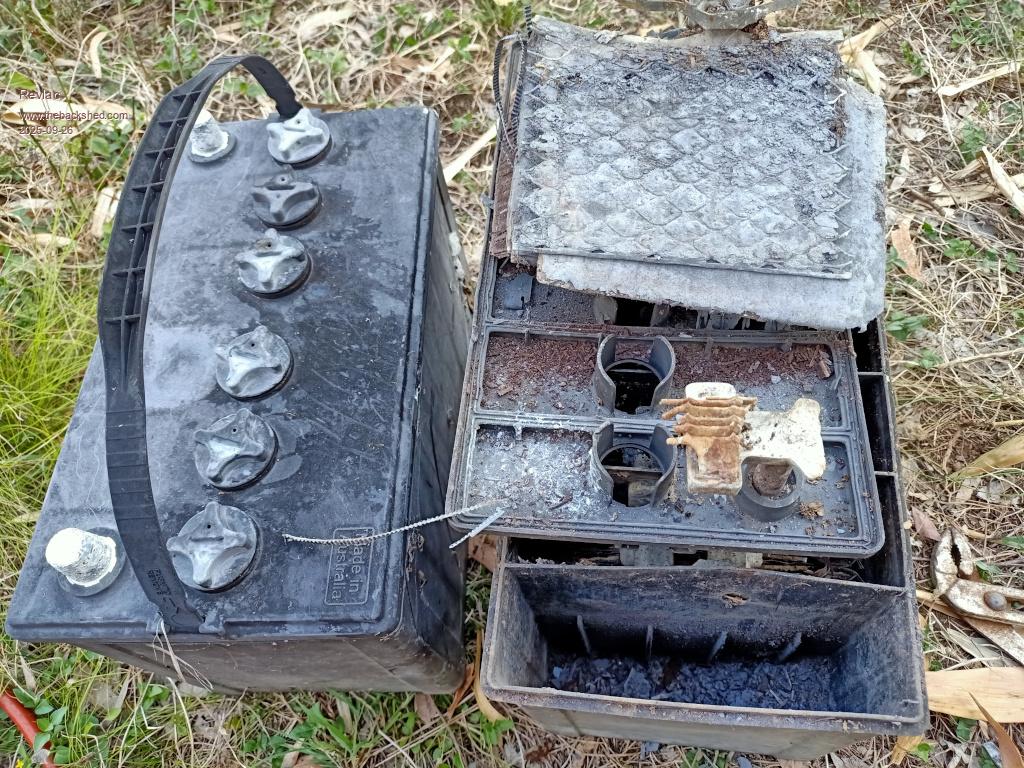 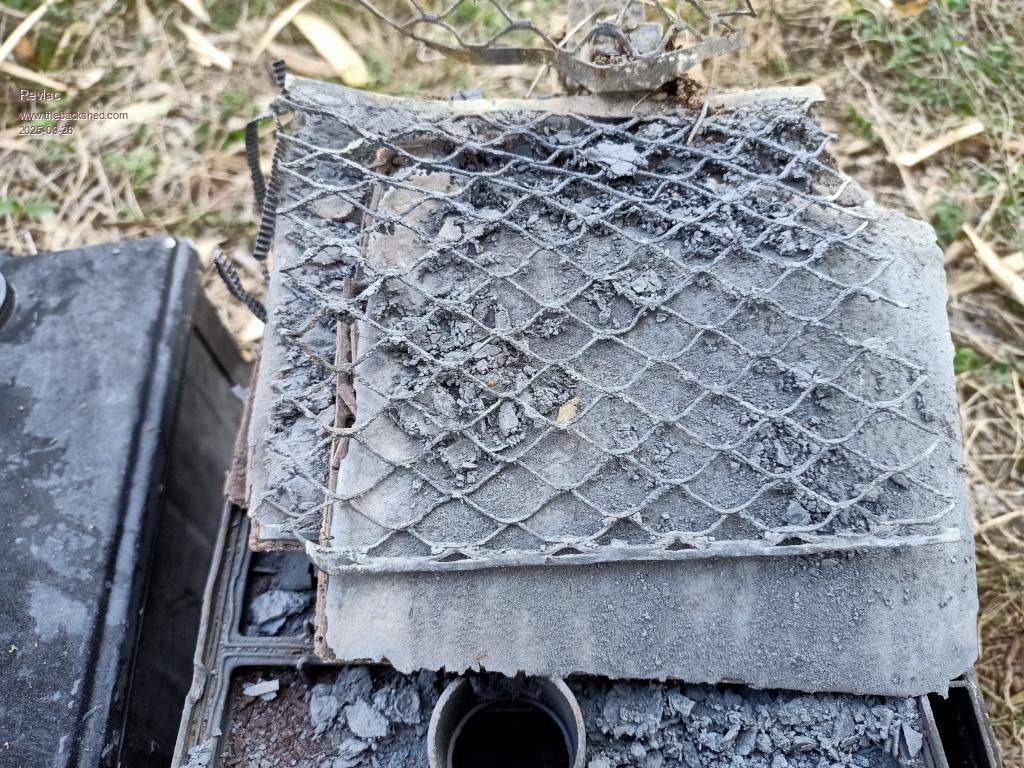 |
||||||
Modern battery plates are not pure lead, they are alloys and when smelted can give off deadly gases. Industrial plants have air scrubbers to handle this... Be careful! Mary |
||||||
Hi Aaron, nice to read your experiences. It does seem that modern batteries are being made cheaper than they used to be. I have had AGM batteries die on me too. I didn't pull them apart though. It looks like your dead battery pile is pretty big, I took a load of old telecom batteries to a scrap dealer a few years back, they paid me well for them. Interesting information on your experiences with Lithium batteries. I guess the ones that go up in smoke are probably really cheaply made with dodgy chargers. Cheers Pete |
||||||
Hi Pete, Yeah cheaper materials in some batteries, while making it harder to find the good quality amongst them. I currently use Amaron Automotive starting Batteries, they seem to be quite good for the old tractors etc. You would probably remember a long time back there was a lot of offgrid setups and the battery choice was quite often Raylite Batteries, there are a few reports of them not doing as well as they used to, this is from users that had them previously, stayed with the same brand, I looked at them years ago and there were very pricey back then. I had some old UK made AGM batteries, I think they were, will post a picture and details later. Around 15 years ago you hardly heard of any battery fires with these 18650 cells, I had a lot of them from medical equipment so they had to be good, still have a set of those running my weed sprayer they were made in 2009, take into account that weed spraying is not that often and mostly only spring and summer. When we had the Ambulance come in, I was surprised by how much of there gear is battery powered, mostly lithium powered I think so good quality reliable.  Saw this the other day, https://www.theverge.com/news/784966/lumafield-x-ray-ct-scan-lithium-ion-battery-risks-manufacturing-defect And another reason I don't buy any batteries or battery powered stuff overseas, if anyone has recently best to check if the 18650's are fake. |
||||||
Aaron, I have had a pretty extraordinary experience with an automotive battery. I bought a new Diesel Jeep Grand Cherokee in 2014. It has an AC Delco AGM under the passenger seat. The 200,000 km service is due next week. The car is still running with its original battery ( touch wood ) I am well aware that for the last half a dozen years I have been living on borrowed time. The brake pads & rotors are still original but expect there is only a few mm left on the pads by now. The battery still sounds so strong when starting I decided to leave it alone and undertake a ~ 12,000 km trip up through the middle & all over WA ( currently in Perth). I doubt that everyone will believe this story, but when it finally dies I will take some pics of date code etc. I am taking the attitude of if it ain’t broke leave it alone. I am confident that if I was prudent and replaced the battery routinely ~ 6 years ago its replacement would have died long ago so now curiosity stops me replacing it. I have never accidentally run the battery flat and it has never seen a charger other than via the alternator. Lastly to date the total cost of spare parts for the car is 8$ to replace a cracked plastic connector for the drivers side window washer a few years back. Apart from services & tyres and fuel it’s been a good run given that at least 30,000km was towing a ~ 2.5T van. |
||||||
There are some batteries that will do a very good job and outlast many others even those of the some brand bought at the same time treated the same way, currently I'm, doing very well with the Amaron batteries, a friend had 2 ACDelco N200 batteries in his bus they went very well, have to also take into account that starter motors current draw can vary a lot depending on brand and other things, I checked with a clamp meter and was surprised, the starter on his bus used less than half the amperage than the other spare motor and starter. Lawn mower stater was fairly high amperage as well, very harsh on the small battery it had. The Jeep ACDelco might be the AGM stop start battery, just looked and they are quite a few$$$  Your vehicle and battery is going well,  Have a good holiday and a safe trip Mike. Have a good holiday and a safe trip Mike. |
||||||
You are correct I checked the Delco part number and it is a stop start type - I disabled that within the first hour of owner ship. The replacement battery cost is ~ $460 and offers a whole 2 year warranty, so it is doing well. I haven’t tried to measure the cranking current, apart from the cable being buried in the jungle & the battery is enclosed under the front passenger seat, it starts in what feels like 0.5 - 1 second so I would need a peak hold amp clamp to catch it. I suspect it would be a pretty big surge though to spin it up so quickly. Slightly off topic Cheers! |
||||||
| The Back Shed's forum code is written, and hosted, in Australia. |